Canon PowerShot SX20 IS
-
-
Written by Gordon Laing
Canon PowerShot SX20 IS lens and stabilisation
The Canon PowerShot SX20 IS’s headline feature is its massive 20x optical zoom range – it shares the same optics as its predecessor which deliver an equivalent range of 28-560mm and a focal ratio of f2.8-5.7. The actual focal length is 5-100mm and we counted 28 discrete steps when zooming from wide angle to telephoto.
|
When powered-up the barrel extends by 18mm from its housing, with the camera ready for action in 1.3 seconds – that’s roughly the same time as the Panasonic FZ38 / FZ35. As the camera zooms-in, the barrel steadily extends to 49mm from its housing and you’ll notice markings indicating actual and equivalent focal length. You can see how this looks in the photo to the left which from top to bottom shows the SX20 IS switched off, switched on, then fully zoomed-in.
Like its predecessor, the SX20 IS employs a USM motor to power the zoom (not the focus), and it offers two speeds depending on how far you push the rocker. The slower of the two is virtually silent which allows Canon to enable the optical zoom during video recording – an unusual but very welcome facility which we’ve demonstrated several times in our video tour.
Canon has kept the same small lens cap as its predecessor, which simply clips onto the extending portion of the lens barrel, so you can happily power-up the camera without worrying. This is more convenient than the Panasonic FZ38 / FZ35 which has a larger cap which clips firmly to the outer lens housing and blocks the extension during power-up, forcing the owner to remove it and press any key to proceed.
The SX20 IS also comes with a small lens hood which clips onto the front of the extending barrel and can be reversed over the lens housing when not in use. Panasonic supplies a larger and more effective lens hood with the FZ38 / FZ35, but it needs to be screwed into place and may require subsequent rotating and locking with a thumbscrew before it’s in the right orientation. Its larger size also prevents it from reversing over the lens housing.
Like its predecessor, The SX20 IS’s closest focusing distance is 10cm in Macro mode and 0cm in Super Macro with the lens locked to wide-only – that’s right, zero cm. This means the camera can stay focused even with the subject virtually pressed against the front of the barrel. Of course within a couple of cm, it’s hard to avoid casting a shadow on the subject, while at 0cm, you’re really looking at backlit objects, but it’s still an impressive and welcome feature to have at your disposal.
The most impressive aspect of the SX20 IS’s lens though is of course its massive optical zoom, which is a little longer than the 18x of the Panasonic FZ38 / FZ35. It may be shorter than the 26x of the Olympus SP-590UZ, but remains a considerable range to have at your disposal which should cover most situations.
To illustrate the Canon’s coverage we mounted it on a tripod and shot the same scene fully zoomed-out, then fully zoomed-in. We then shot the same scene from the same position using its arch rival, Panasonic Lumix DMC-FZ38 / FZ35 which is equipped an 18x zoom with an equivalent range of 27-486mm.
|
Canon PowerShot SX20 IS coverage wide |
Panasonic Lumix FZ38 / FZ35 coverage wide | |
 |  | |
5-100mm at 5mm (28mm equivalent) |
4.8-86.4mm at 4.8mm (27mm equivalent) |
Above you can see examples of both cameras fully zoomed out. Panasonic quotes the FZ38 / FZ35 as having 27mm equivalent coverage to the SX20 IS’s 28mm, but as you can see here they’re essentially delivering identical fields of view. But the important thing is they’re both offering true wide angle coverage.
Canon PowerShot SX20 IS coverage tele |
Panasonic Lumix FZ38 / FZ35 coverage tele | |
 |  | |
5-100mm at 100mm (560mm equivalent) |
4.8-86.4mm at 86.4mm (486mm equivalent) |
Above are examples taken with each camera fully zoomed-into their maximum focal lengths. The 560mm equivalent of the Canon SX20 IS is clearly capturing a tighter field of view than the 486mm of the Panasonic FZ38 / FZ35, but in practice it may not look as much as the 74mm difference implies when written down. So while the SX20 IS beats the Panasonic in terms of overall coverage, the examples above illustrate there’s not a massive amount in it. Both cameras sport extremely broad zoom ranges which offer amazing opportunities in practice, and you can compare their quality in our results pages.
Finally, a quick note on aperture. The SX20 IS has a focal ratio of f2.8~5.7, while the FZ38 / FZ35 is f2.8~4.4. The SX20 IS’s aperture slows down quite quickly, only offering its brightest f2.8 between 28 and 34mm. F3.2 is between 34 and 50mm, followed by f3.5 between 50 and 67mm. F4 kicks-in between 67 and 112mm, and f4.5 between 112 and 168mm. Then it’s f5.0 for a large portion of the range between 168 and 460mm, with f5.7 for the remaining 100mm of the range. So when the SX20 IS and the FZ38 / FZ35 are both at 486mm, the Canon is around 2/3 of a stop slower.
Canon PowerShot SX20 IS image stabilisation
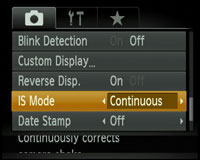 |
The Canon SX20 IS features Image Stabilisation, which is pretty essential when it comes to handholding shots at an equivalent of up to 560mm. Like its other recent models, Canon offers three modes: Continuous where the system operates all the time, Shoot Only which only applies stabilisation as you take the photo, and Panning which only stabilises in the vertical axis for when you’re moving the camera horizontally as you take the photo – for an example of using the latter, see the Blurring Action tutorial at our sister site, DSLR Tips.
To put the SX20 IS’s stabilisation to the test we photographed a distant building with the lens fully zoomed-into its maximum equivalent focal length of 560mm, first with stabilisation disabled, then with stabilised set to the default Continuous mode. Traditional photographic advice would recommend a shutter speed of 1/560 to completely eliminate camera shake without stabilisation.
Canon PowerShot SX20 IS Image Stabilisation off / on (Continuous) | ||
 |  | |
100% crop, 5-100mm at 100mm, 1/60, 80 ISO, IS off |
100% crop, 5-100mm at 100mm, 1/60, 80 ISO, IS on | |
We took a sequence of shots starting at 1/500 in Shutter Priority, reducing in speed one stop at a time until 1/15. Above are 100% crops from the samples taken without, then with stabilisation at a shutter speed of 1/60 – the slowest we could reliably handhold with stabilisation. The version without stabilisation is unsurprisingly shaky, but the version with stabilisation is 100% shake-free, and the shot at 1/30 also looked pretty good, albeit not quite 100% sharp.
The slowest speed we could enjoy a shake-free result without stabilisation under these conditions was at 1/500, so achieving this at a shutter speed of between 1/60 and 1/30 corresponds to around 3.5 stops of compensation, which is a good result for the SX20 IS. It makes the huge focal range very usable, even when handheld. Note, Panasonic improved the stabilisation on its FZ38 / FZ35, and in our tests it proved slightly more effective than the Canon, especially when filming video with the lens fully zoomed-in.
Canon PowerShot SX20 IS focusing
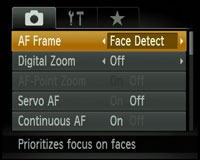 | 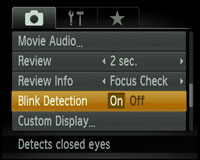 |
The Canon PowerShot SX20 IS offers the choice of two AF frames: Face Detect and FlexiZone. In Face Detect mode, the SX20 IS will track up to 35 faces and depending on the shooting mode, will automatically adjust the exposure, white balance and if necessary, the flash power for the faces. The camera’s DIGIC 4 processor also does a good job staying locked-onto subjects turned to almost complete profile.
New to the SX20 IS over its predecessor is Blink Detection, which as its name suggests, can spot when a subject has blinked at the moment the photo was captured. This works in practice, briefly displaying a blinking face icon in the corner of the screen as a warning immediately after taking the photo. It will however only work if the subject in question has already been acquired by the face detection system.
Pressing the AF area button on the back of the camera while in FlexiZone mode, allows you to move the focusing area around most of the frame; pressing the DISP button switches between large and small focusing areas.
An AF Point zoom option temporarily enlarges the active focus area when the shutter release button is half-pressed. If you’ve opted for Focus Check under Review Info, the camera will also display an enlarged portion of the active focus area immediately after taking the image – particularly handy for quickly checking the expressions of people taken with face detection.
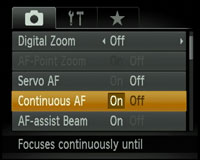 |
There’s also the choice of two AF modes: the default Continuous option adjusts the focus all the time to ensure the camera is close or even spot-on when you come to take the photo, and Single, which only focuses when you half-press the shutter release to save power.
In use, the SX20 IS was fairly quick at focusing, snapping onto subjects with the minimum of fuss or searching, even when fully zoomed-in. In low light it became slower and occasionally searched, but rarely gave us any issues. There’s a definite speed benefit to using the Continuous AF mode in normal operation, although there’s understandably reduced battery life as a consequence.
We compared the AF performance side by side with the Panasonic FZ38 / FZ35 and its rival enjoyed a slight edge in speed, although the Canon’s certainly no slouch.
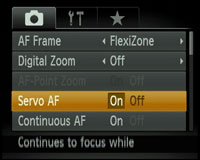 |
DIGIC 4 also equips the SX20 IS with Servo AF facilities which can track subjects in motion while the shutter is half-pressed (although not once you start shooting). This worked reasonably well in practice with moving subjects including the steamship seen the Gallery, although the camera’s disappointing continuous shooting rates (see bottom of page) make it unsuitable for capturing fast action sequences.
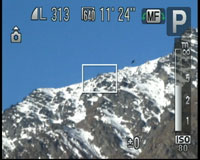 |
Pushing the thumb wheel upwards sets the camera into Manual Focus mode, after which you can use the thumb wheel to adjust the focusing distance, indicated by an on-screen scale. If MF Point Zoom is enabled in the menu, the portion in the AF frame is magnified by approximately two times. This allows you to better judge the manual focus, but not as easily as models with larger and higher resolution screens.
If you’d like a little extra help with manual focusing, the Safety MF option lets you get the focusing close by hand, then finishes it off automatically at a press of the focus point select button. Alternatively you can opt for the focus bracketing mode which takes three shots: one at the manually focused distance, and the others a little closer and further. The nearer and further increments can be set to small, medium and large.
Canon PowerShot SX20 IS sensor and processing
|
The Canon PowerShot SX20 IS is equipped with a 12.1 Megapixel CCD sensor, measuring 1/2.3in and delivering 4:3 shaped images with a maximum resolution of 4000×3000 pixels. The sensor resolution of the Panasonic FZ38 / FZ35 is identical, but check out our results pages to see how they compare in practice.
As before, there’s the choice of four lower resolutions (8, 5 and 2 Megapixels plus a VGA mode) along with a cropped 16:9 aspect ratio. Images can be recorded in the choice of Normal or Fine JPEG compression, although sadly the SuperFine option of its predecessor is no longer available. This is a shame as the SX20 IS applies relatively high compression even in its Fine mode, and there’s no options for anything milder.
As before, there’s no RAW option as standard, and this remains a key difference between it and the Panasonic Lumix FZ38 / FZ35, along with Canon’s own PowerShot SX1 IS and G11. Some relief may be at hand with a future edition of CHDK though, which might unofficially add RAW or milder compression options to the SX20 IS. Remember this is very much an unofficial solution though, and may not happen.
 | 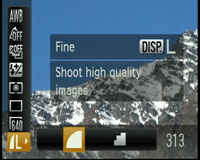 |
Its sensor gives the SX20 IS two extra Megapixels over its predecessor, and allows its images to be printed up to 13.3x10in at 300dpi – that’s roughly an inch taller and wider than before, although since the extra pixels are packed-into the same area, it obviously raises the usual concerns over increased noise and reduced dynamic range.
Best quality Large Fine JPEGs measure around 3MB each, which are noticeably smaller than the 4.5-6MB of best quality JPEGs on the FZ38 / FZ35. Obviously this means you’ll squeeze more images onto a memory card using these best quality settings, but cards are cheap these days and again we’d sooner see an option for milder compression on the SX20 IS. As before, there’s no built-in memory.
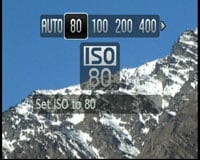 |
The sensitivity at full resolution runs from 80 to 1600 ISO and is adjusted by pushing the thumb wheel right and then either turning it or pressing it left and right. A 3200 ISO option is offered through the Scene preset menu, but operates at a greatly reduced resolution of just 2 Megapixels.
There’s also an Auto ISO option, although the cunning Auto ISO Shift facility of its predecessor appears to be missing; this allowed the camera to warn you (and optionally boost the sensitivity at the press of the Direct Print button) if it thought there’d be shake at the current shutter speed.
Sticking with the sensitivity, there’s still no noise reduction options to adjust on the SX20 IS, unlike the Panasonic FZ38 / FZ35 which allows you to tweak it by +/-2 levels.
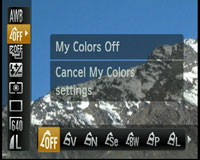 | 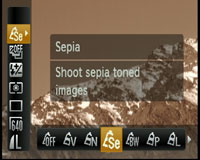 |
Contrast, Sharpness, Saturation and other colour settings are applied using a variety of options in the My Colours section of the Function menu. Along with the default Off setting, the SX20 IS offers Vivid, Neutral, Sepia, Black and White (but no filter options), Positive Film, Lighter Skin Tone, Darker Skin Tone, Vivid Blue, Vivid Green, Vivid Red and a Custom option which lets you adjust the Contrast, Sharpness, Saturation, Red, Green and Blue channels, along with Skin Tone by +/-2 steps. We used the default Off setting and found the SX20 IS delivered natural-looking images with a slight bias towards punchier output – see the Results and Gallery pages for samples and comparisons.
The Function menu also lets you adjust the White Balance between Auto, Daylight, Cloudy, Tungsten, Fluorescent, Fluorescent High, Flash, or a single Custom setting; like most non-DSLRs, there’s no manual entry of colour temperature, nor fine tuning of the white balance.
Finally, the DIGIC 4 processor offers automatic dynamic range adjustments using its i-Contrast feature (disabled by default). i-Contrast automatically boosts shadow areas or faces darkened by strongly backlit scenes. To put it to the test we took two photos of a Church interior with and without i-Contrast set to its Auto option. This composition features dark shadow areas and strong window lighting which represents a challenge for any camera’s exposure system.
|
Canon PowerShot SX20 IS i-Contrast (off / Auto) | ||
|
| ||
i-Contrast Off: 80 ISO, f3.2, 1/4 sec |
i-Contrast Auto: 80 ISO, f3.2, 1/4 sec | |
The example above shows i-Contrast selecting the same exposure when set to its Auto mode, and like its predecessor, the effect is fairly subtle in this particular example. i-Contrast has had no benefit on the saturated windows, but as the histograms reveal, there’s a reduction in shadow tones with a shallower climb to their peak, and a slight boost in upper mid-tones. Their effect can be seen in the shrunken versions of each image, especially in the dark roof area in the upper right corner. Like other systems which boost shadow areas though, there’s inevitably an increase in visible noise as a result, especially if you’re using anything but the lowest sensitivity.
Canon PowerShot SX20 IS Movie mode
Video recording was already a highlight on the earlier SX10 IS, but in a major and very welcome upgrade, the new SX20 IS now adds an HD option in the 720p format; this brings it in-line with the movie resolution of its arch rival, the Panasonic FZ35 / FZ38, and also a little closer to the SX1 IS.
Like its predecessor, there’s a dedicated button on the back to start recording regardless of your shooting mode, and you’re also able to adjust the optical zoom while filming – which thanks to the quiet USM motor is barely audible. If the HD mode is selected, the SX20 IS also overlays a white 16:9 frame on the screen or in the viewfinder so you know exactly what you’re going to capture before pressing the big red record button – see middle screengrab below.
Impressively the Continuous AF also manages to keep the subject sharp most of the time whether it’s in motion or the camera’s zooming. And again unlike most still cameras, the audio quality is very good, and even recorded in stereo thanks to the decent built-in microphones above the lens housing. You can also use the Digital Zoom for even greater magnification, although unlike the SX1 IS’s movie teleconverter option, this just seems to scale-up a lower resolution portion of the image – so while the frame is tighter, the quality is reduced.
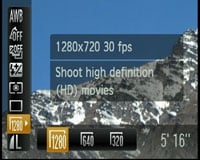 |
 |
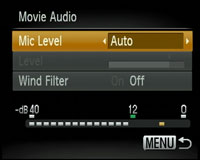 |
Along with the new 1280×720 HD option, the PowerShot SX20 IS can capture video at lower resolution 640×480 or 320×240 formats, all at 30fps. Like most Canon models which employ DIGIC 4, the SX20 IS compresses its video using the modern H.264 format and encodes audio as Linear PCM at 16 bit / 44.1KHz, then stores the result in a QuickTime MOV wrapper. The maximum movie length is a second shy of 30 minutes per clip in HD or one hour per clip in the other formats, or when the file size reaches 4GB. In our tests, the HD mode consumed around 3Mbyte/s, so you’re likely to hit the 4GB limit before the half hour limit – at 3Mbyte/s, you’d reach 4GB after about 22 minutes of HD.
Note the non-European version of Panasonic’s FZ35 can keep recording in its 720p AVCHD mode until you run out of memory. Individual files may also be no bigger than 4GB, but unlike the SX20 IS, the Panasonic just starts a new file every 4GB and keeps recording with no interruption on playback – we confirmed this by recording a 45 minute interview on the FZ35 which consisted of two files, measuring 4GB and 500MB. Sadly this is not possible on the European FZ38 version though, which due to tax regulations is limited to 29 minutes and 59 seconds.
The 720p HD movie mode on the SX20 IS delivers great-looking footage that’s a big step-up in detail over the standard VGA modes, while avoiding the over-sharpening of some models.
You can see an example here, handheld with Continuous Stabilisation (the only IS option when filming) and demonstrating the broad optical towards the end of the clip – registered members of Vimeo can also download the original file for closer inspection.
We shot the same sequence moments apart with the Panasonic Lumix DMC-FZ38 / FZ35 (in its Motion JPEG 720p mode for compatibility with Vimeo), and you can download the original file here for comparison.
Another difference between the cameras are the compression options. Panasonic’s FZ38 / FZ35 offers 720p modes at 9, 13 or 17Mbit/s, while Canon’s 720p HD mode is fixed at a much higher rate of around 24Mbit/s, which again works out at about 3Mbyte/s. Quality fanatics will be pleased to see such mild compression, but it will eat through your memory card much quicker, especially with no lower quality alternatives. It should also be mentioned the HD video from the Panasonic at 17Mbit/s didn’t appear to be suffering from greater compression artefacts. It’s a shame Canon isn’t offering lower bit rate options on these latest models, but at least the 720p mode here is more manageable than the 40-50Mbit/s consumed by the 1080 mode on the SX1 IS. Note, we used VLC player and Adobe Premiere Pro CS4 under Windows Vista to play and edit the SX20 IS’s movie files – both programs worked very well.
It is however worth noting Panasonic’s FZ38 / FZ35 offers an alternative Motion JPEG compression option, which is easier to edit and playback on a computer than the AVCHD / H.264 modes, and while it’s less compressed than the FZ38 / FZ35’s other modes, the bit rate is actually only slightly higher than Canon’s only 720p mode. The FZ38 / FZ35 additionally boasts a new Manual exposure mode which lets you record movies in Program, Aperture or Shutter Priority or full Manual modes. Admittedly it’s still tricky to achieve a small depth of field with a non-DSLR even if you choose the smallest f-number, but it’s still good to have the option to tweak the exposure if desired. So while the 720p mode on the SX20 IS is a great upgrade over its predecessor, the video capabilities of the FZ38 / FZ35 are ultimately more powerful – although of course these benefits could be out-weighed by the articulated screen on the Canon for many people.
Canon PowerShot SX20 IS Drive modes
The Canon PowerShot SX20 IS offers two continuous shooting options, and disappointingly the ‘fastest’ one is slower than the already modest capabilities of its predecessor. The SX10 IS could shoot at 1.4fps with its focus locked, or 0.7fps with autofocus. The SX20 IS sticks with the 0.7fps rate with autofocus, but drops the locked-focus option to 1fps. Yep, the fastest continuous shooting option on the SX20 IS is just 1fps.
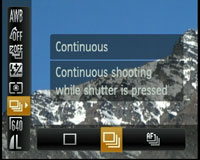 |
To put this to the test we fitted the SX20 IS with a formatted Lexar Professional 133x 8GB SDHC card and captured 50 Large Fine JPEGs at 80 ISO in 48 seconds. That may be fractionally faster than quoted, but 1.04fps is certainly nothing to be proud of. Like its predecessor, this is way too slow to effectively capture almost any kind of action sequence, and the ability to keep shooting until you run out of memory is no consolation.
In contrast, the Panasonic Lumix FZ38 / FZ35 takes a more sensible approach to continuous shooting. Its buffer can capture five standard quality JPEGs at 2.3fps – a speed that may still not be that impressive, but well over double that of the SX20 IS. Alternatively there’s the High Speed Scene preset which drops the resolution to a mere 3 Megapixels, but allows you to shoot up to 100 images at up to 10fps. Both modes involve compromises and can’t match what you’d enjoy from a typical DSLR, but they better-equip the FZ38 / FZ35 for action sequences than the SX20 IS. Perhaps Canon is deliberately keeping the shooting rate and buffer low in order not to intrude into the SX1 IS’s market, but by making the continuous shooting effectively useless on the SX20 IS, it’s as likely to push people towards the Panasonic as it is to its own pricier model. Speaking of the SX1 IS, the secret behind its faster 4fps continuous shooting is down to the quicker readout of its CMOS sensor.
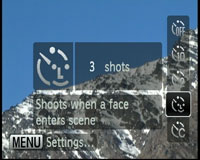 | 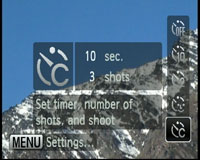 |
While continuous shooting on the SX20 IS is a disappointment, Canon has at least put some considerable effort into the self-timer section. Along with traditional ten and two second timers, the Custom option lets you set the countdown to as long as 30 seconds, and have the camera take one to ten shots at the end. This is handy for maximising your chance of successful poses and expressions in timed group shots.
Cleverer still is the Face Timer option, courtesy of DIGIC 4. This waits until a new face enters the frame before taking the photo two seconds later; you can also change the number of shots taken from one to ten. Now let’s see how the SX20 IS compares against its arch rival, the Panasonic FZ38 / FZ35 in terms of image quality in our results pages.






